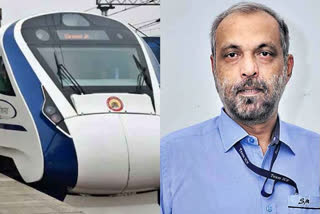Hyderabad: The semi-high-speed train 'Vande Bharat Express' also known as Train 18 is set to revolutionize the railways. In the budget 2022-23, Finance Minister Nirmala Sitharaman laid out the grand plan of introducing 400 semi-high-speed, next-generation Vande Bharat trains in the next three years. Built with entirely indigenous technology and designed at the lowest cost, the Vande Bharat trains are touted to be the game changer for the Railways. Sudanshu Mani is the former General Manager of the Integral Coach Factory where the first Train 18 was manufactured in Chennai. In an exclusive interview with ETV Bharat, Mani talked about his experience of developing India's first semi-high-speed train.
ETV Bharat (EB): How did you get the idea to manufacture the country's first semi-high-speed train?
Sudanshu Mani (SM): India needed a modern train set for decades as the trend world-over had changed to the manufacture of train sets, usually a train with permanently coupled coaches without any locomotive and all the equipment mounted under the board. The project was, however, not happening. I asked for and got the posting of General Manager of Integral Coach Factory, (ICF) in 2016, unlike others who opt for a bigger zonal railway posting, because I had this dream and the vision, for a long time, to get a modern and fast train, with pleasing interiors and exteriors, designed and manufactured in India.
This was going to be, in all likelihood, my last assignment before superannuation, after completing nearly life-long service of 35 years as a railway officer, including a rare stint in Germany in the Embassy of India as the Minister (Railways). So, I had the dream, the vision, and perhaps the last opportunity to fulfill my dream.
I realized that I also had the good fortune that a great team, raring to go, was bequeathed to him. The officers and staff of ICF had the right capability and the chutzpah to take up a project of a new train design and manufacture it de novo, from scratch. The support industries in India had also reached near world-standard in certain key areas and were waiting for a friendly nudge to excel themselves. All it needed was to channel this energy to bring something noteworthy to fruition. I cherished the memories of those heady days when the team spent improving ICF in general and getting this train made in particular.
EB: Is the design and technology of the self-propelled system for this semi-high-speed indigenous and developed solely in India?
SM:Our train turned out to be cheaper because we decided that all R&D and design would be done by ICF and supported by allied Indian industry. Now, there were some areas out of more than a hundred where we felt that our capability was not quite world-class in three areas. Shakespeare has said through Touchstone in ‘As You Like It’, “The fool doth think he is wise, but the wise man knows himself to be a fool.”
So we had to accept this deficiency and make up for it as a ‘witty fool’ and not a ‘foolish wit’, a la Feste in the play Twelfth Night. Having decided that the train would have an IPR fully owned by ICF, we did not want to go to any multinational for assistance. So we engaged consultants, small firms which provide design consultancy.
The caveat was that everything that they do would be in association with ICF’s technical staff so that next time we need to design a better train, they would do it all by themselves. Moreover, we tried to source as many sub-assemblies, equipment, and components in India, instead of importing them and that had a cascading effect in lowering the price. The technology is, therefore, fully indigenous with IPR resting with ICF.
EB: The concept and development are one part, how did we get the manufacturing ecosystem in less than 2-3 years, so that we could build a complete train?
SM: Well, it was not ICF’s manufacturing eco-system alone but that of allied manufacturer-supplier from the allied industry as well. The team worked hard to upgrade the manufacturing culture and facilities in ICF and the allied industry also rose to the occasion.
EB: Do we have the capacity to roll out VB trains for our requirements and also to meet exports? To what extent the speed of the VB train increased further?
SM: First, the VB train is so designed that it can be upgraded to 200 Kmph with some modifications. But that is in the future, as of today, IR does not have adequate infrastructure even for running the train to its potential of 160 kmph. This brings us to the question of how many trains can we can run today in India.
After the two rakes were turned out in 2019, there had a lull but we will not go into that negativity and venal vilification of the train and the team that followed; the two trains continued giving trouble-free service. There is no point in recounting the negativity as we knew all along that no wrong had been done and no mud would eventually stick. Precious time was, however, wasted due to these machinations.
Things, however, changed dramatically since the present Minister of Railways took over and the vibes today are great. There have been various announcements: by the PM on 15th August 21 that 75 such trains would ply across the country in 75 weeks and the budget by Finance Minister that 400 Vande Bharat trains would be manufactured in the coming three years and so on.
